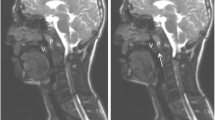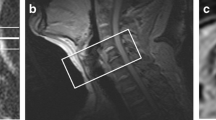Abstract
Background
In the past decade, there has been increased utilization of magnetic resonance imaging (MRI) in evaluating and understanding velopharyngeal insufficiency (VPI). To our knowledge, none of the prior studies with MRI has simultaneously linked the audio recordings of speech during cine MRI acquisition with the corresponding images and created a video for evaluating VPI.
Objective
To develop an MRI protocol with static and cine sequences during phonation to evaluate for VPI in children and compare the findings to nasopharyngoscopy and videofluoroscopy.
Materials and methods
Five children, ages 8–16 years, with known VPI, who had previously undergone nasopharyngoscopy and videofluoroscopy, were included. MRI examination was performed on a 3-T Siemens scanner. Anatomical data was obtained using an isotropic T2-weighted 3-D SPACE sequence with multiplanar reformation capability. Dynamic data was obtained using 2-D FLASH cine sequences of the airway in three imaging planes during phonation. Audio recordings were captured by a MRI compatible optical microphone.
Results
All five cases had MRI and nasopharyngoscopy and four had videofluoroscopy performed. VPI was identified by MRI in all five patients. The location and severity of the velopharyngeal gap, closure pattern, velar size and shape and levator veli palatini (LVP) muscle were identified in all patients. MRI was superior in visualizing the integrity of the LVP muscle. MRI was unable to identify hemipalatal weakness in one case. In a case of stress-induced VPI, occurring only during clarinet playing, cine MRI demonstrated discordant findings of a velopharyngeal gap during phonatory tasks but not with instrument playing. Overall, there was satisfactory correlation among MRI, nasopharyngoscopy and videofluoroscopy findings.
Conclusion
Cine MRI of the airway during speech is a noninvasive, well-tolerated diagnostic imaging tool that has the potential to serve as a guide prior to and after surgical correction of VPI. MRI provided superior anatomical detail of the levator musculature. The creation of a video with recorded phonation allowed correlation between palatal movements and specific phonatory tasks.








Similar content being viewed by others
References
Abdel-Aziz M, El-Hoshy H, Ghandour H (2011) Treatment of velopharyngeal insufficiency after cleft palate repair depending on the velopharyngeal closure pattern. J Craniofac Surg 22:813–817
Schuster T, Rustemeyer J, Bremerich A et al (2013) Analysis of patients with a cleft of the soft palate with special consideration to the problem of velopharyngeal insufficiency. J Craniomaxillofac Surg 41:245–248
Ruda JM, Krakovitz P, Rose AS (2012) A review of the evaluation and management of velopharyngeal insufficiency in children. Otolaryngol Clin North Am 45:653–669
Shprintzen RJ, Marrinan E (2009) Velopharyngeal insufficiency: diagnosis and management. Curr Opin Otolaryngol Head Neck Surg 17:302–307
Tian W, Redett RJ (2009) New velopharyngeal measurements at rest and during speech: implications and applications. J Craniofac Surg 20:532–539
Barr LL, Hayden CK Jr, Hill LC et al (1989) Radiographic evaluation of velopharyngeal incompetence in childhood. AJR Am J Roentgenol 153:811–814
Stringer DA, Witzel MA (1986) Velopharyngeal insufficiency on videofluoroscopy: comparison of projections. AJR Am J Roentgenol 146:15–19
Lam DJ, Starr JR, Perkins JA et al (2006) A comparison of nasendoscopy and multiview videofluoroscopy in assessing velopharyngeal insufficiency. Otolaryngol Head Neck Surg 134:394–402
Ettema SL, Kuehn DP, Perlman AL, Alperin N (2002) Magnetic resonance imaging of the levator veli palatini muscle during speech. Cleft Palate Craniofac J 39:130–144. doi: 10.1597/1545-1569(2002)039<0130:MRIOTL>2.0.CO;2
Kao DS, Soltysik DA, Hyde JS et al (2008) Magnetic resonance imaging as an aid in the dynamic assessment of the velopharyngeal mechanism in children. Plast Reconstr Surg 122:572–577
Kuehn DP, Ettema SL, Goldwasser MS et al. (2001) Magnetic resonance imaging in the evaluation of occult submucous cleft palate. Cleft Palate Craniofac J 38:421–431. doi: 10.1597/1545-1569(2001)038<0421:MRIITE>2.0.CO;2
Maturo S, Silver A, Nimkin K et al (2012) MRI with synchronized audio to evaluate velopharyngeal insufficiency. Cleft Palate Craniofac J 49:761–763
Rowe MR, D’Antonio LL (2005) Velopharyngeal dysfunction: evolving developments in evaluation. Curr Opin Otolaryngol Head Neck Surg 13:366–730
Silver AL, Nimkin K, Ashland JE et al (2011) Cine magnetic resonance imaging with simultaneous audio to evaluate pediatric velopharyngeal insufficiency. Arch Otolaryngol Head Neck Surg 137:258–263
Beer AJ, Hellerhoff P, Zimmermann A et al (2004) Dynamic near-real-time magnetic resonance imaging for analyzing the velopharyngeal closure in comparison with videofluoroscopy. J Magn Reson Imaging 20:791–797
Ha S, Kuehn DP, Cohen M et al (2007) Magnetic resonance imaging of the levator veli palatini muscle in speakers with repaired cleft palate. Cleft Palate Craniofac J 44:494–505
Lindman R, Paulin G, Stal PS (2001) Morphological characterization of the levator veli palatini muscle in children born with cleft palates. Cleft Palate Craniofac J 38:438–448. doi: 10.1597/1545-1569(2001)038<0438:MCOTLV>2.0.CO;2
NessAiver MS, Stone M, Parthasarathy V et al (2006) Recording high quality speech during tagged cine-MRI studies using a fiber optic microphone. J Magn Reson Imaging 23:92–97
van der Kouwe AJ, Sagar P, Silver A et al. (2011) Automatic generation of movie with sound during speech production for assessing velopharyngeal insufficiency. Presented at The International Society for Magnetic Resonance in Medicine 19th Annual Meeting, Montreal, Quebec, Canada: International Society for Magnetic Resonance in Medicine, p 4275. http://cds.ismrm.org/protected/11MProceedings/files/4275.pdf
Yoon PJ, Starr JR, Perkins JA et al (2006) Interrater and intrarater reliability in the evaluation of velopharyngeal insufficiency within a single institution. Arch Otolaryngol Head Neck Surg 132:947–951
Atik B, Bekerecioglu M, Tan O et al (2008) Evaluation of dynamic magnetic resonance imaging in assessing velopharyngeal insufficiency during phonation. J Craniofac Surg 19:566–572
Brigger MT, Ashland JE, Hartnick CJ (2010) Injection pharyngoplasty with calcium hydroxylapatite for velopharyngeal insufficiency: patient selection and technique. Arch Otolaryngol Head Neck Surg 136:666–670
Sipp JA, Ashland J, Hartnick CJ (2008) Injection pharyngoplasty with calcium hydroxyapatite for treatment of velopalatal insufficiency. Arch Otolaryngol Head Neck Surg 134:268–271
Drissi C, Mitrofanoff M, Talandier C et al (2011) Feasibility of dynamic MRI for evaluating velopharyngeal insufficiency in children. Eur Radiol 21:1462–1469
Evans A, Driscoll T, Ackermann B (2011) Prevalence of velopharyngeal insufficiency in woodwind and brass students. Occup Med (Lond) 61:480–482
Walter V, Nisa L, Leuchter I (2013) Acute isolated velopharyngeal insufficiency in children: case report and systematic review of the literature. Eur Arch Otorhinolaryngol 270:1975–1980
Conflicts of interest
None
Author information
Authors and Affiliations
Corresponding author
Electronic supplementary material
Below is the link to the electronic supplementary material.
Video 1
Axial oblique mild VPI and sagittal mild VPI. There is small constant velopharyngeal gap throughout the entire axial oblique cine MRI acquisition during “pick up the baby” phrasing. The sagittal cine MRI demonstrates knee-bend configuration of the soft palate with touch closure to the posterior pharyngeal during “Suzie has shoes” phrasing (MPG 1082 kb)
Video 2
Axial oblique moderate VPI. There is a moderate constant velopharyngeal gap with asymmetrical and diminished motion of the left lateral pharyngeal wall during “pick up the baby” phrasing (MPG 1084 kb)
Video 3
Axial oblique mild VPI during phonation and axial oblique, no VPI, during recorder playing. There is a small constant velopharyngeal gap during phonation with “pick up the baby” phrasing; however, no gap was demonstrated during recorder playing (MPG 1094 kb)
Rights and permissions
About this article
Cite this article
Sagar, P., Nimkin, K. Feasibility study to assess clinical applications of 3-T cine MRI coupled with synchronous audio recording during speech in evaluation of velopharyngeal insufficiency in children. Pediatr Radiol 45, 217–227 (2015). https://doi.org/10.1007/s00247-014-3141-7
Received:
Revised:
Accepted:
Published:
Issue Date:
DOI: https://doi.org/10.1007/s00247-014-3141-7




